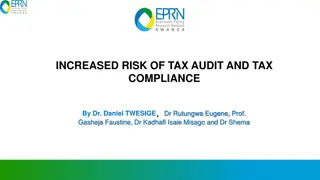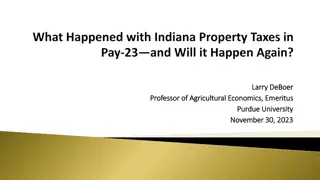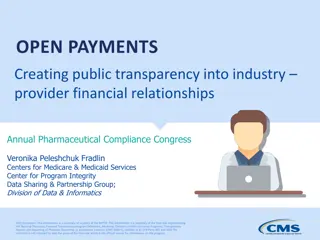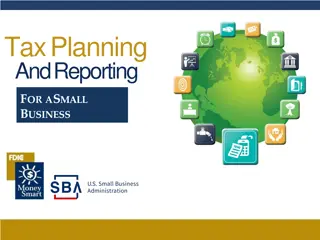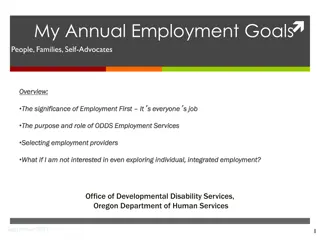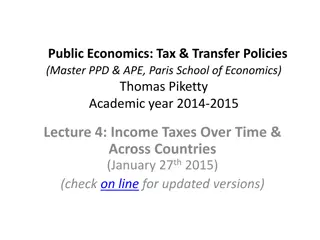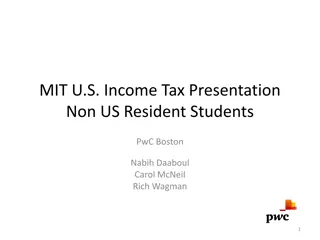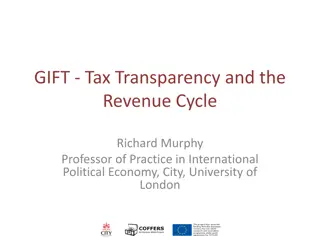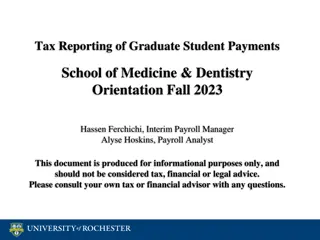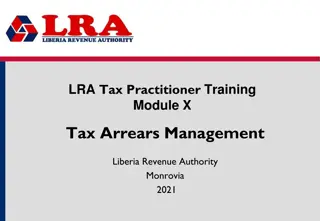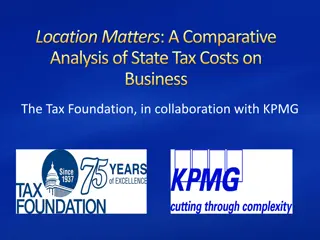
Tax on Employment Payments and Income Sources
Learn about tax implications on income from salary or wages, including important details on employment termination payments, fringe benefits, multiple job income, finding a new job, and lump sum payments. Discover how to navigate tax-free thresholds and claim deductions effectively.
Download Presentation

Please find below an Image/Link to download the presentation.
The content on the website is provided AS IS for your information and personal use only. It may not be sold, licensed, or shared on other websites without obtaining consent from the author. If you encounter any issues during the download, it is possible that the publisher has removed the file from their server.
You are allowed to download the files provided on this website for personal or commercial use, subject to the condition that they are used lawfully. All files are the property of their respective owners.
The content on the website is provided AS IS for your information and personal use only. It may not be sold, licensed, or shared on other websites without obtaining consent from the author.
E N D
Presentation Transcript
Tax on Employment Payments
Tax on Employment Payments Income from salary or wages Sub-topics Employment termination payments (ETPs) Fringe benefits
Income from salary or wages - most common type of employment income Salary and wage payments you need to declare in your tax return include, but may not be limited to: your normal weekly, fortnightly or monthly pay JobKeeper and stand-down payments you receive because of COVID-19 commissions bonuses, including retention bonuses to remain with your employer money for part-time or casual work parental leave pay or dad-and-partner pay payments from an income protection insurance policy a sickness or accident insurance policy a workers compensation scheme pay and allowances for continuous full-time service in the Australian Naval, Army or Air Force Reserve ( may not have to declare salary and allowances while deployed overseas) income you receive in connection with a joint space and defence project unless exempted foreign employment income unless exempted.
Income from more than one job If you have more than one job at the same time, it is recommend that you only claim the tax-free threshold from one payer. The tax legislation only provides one tax-free threshold. Your other payers are required to withhold tax at a higher rate. This is because your all of your income is taxed, without considering the tax-free threshold. It reduces the likelihood of you having a large amount of tax debt at the end of the year when you lodge your tax return.
Finding a new job You are entitled to claim the tax-free threshold to reduce the amount of tax that is withheld from your pay. Consider noting that if changing your job later in the FY, it might be worth not claiming the tax-free threshold from the start, because it would be similar to a second job. In the next FY, you could then update your details to claim the threshold. Note: your new employer will give you a tax file number declaration to complete". Income from salary or wages
Lump sum payments A lump sum payment is a one-time payment that is taxed and reported differently to your salary and wage income. You include lump sum payments as assessable income in your tax return in the income year you receive the payment. You may receive a lump sum payment: when you leave a job, such as an employment termination payment (ETP) a genuine redundancy payment an approved early retirement scheme payment that exceeds the tax-free limit for unused annual leave, long service leave or special leave you are entitled to when you leave a job in arrears (known as back pay or lump sum payments in arrears) for money your employer owes you from an earlier income year.
Employment termination payments (ETPs) When you leave work or change jobs, you may receive several lump sum payments and one of the lump sums may be an ETP, which is generally taxed at a lower rate than your normal income, provided the payment is made within 12 months of your termination. ETPs Not ETPs Payments for unused rostered days off (RDOs) or unused sick leave Genuine redundancy or early retirement scheme payments above the tax-free limit Payments in lieu of notice compensation for loss of job or wrongful dismissal Accrued leave payments Genuine redundancy or early retirement scheme payments up to the tax-free limit Salary, wages, allowances, bonuses Superannuation benefits (a lump sum from super) Employee share scheme payments Etc. A gratuity or golden handshake Etc.
Genuine redundancy amounts A genuine redundancy occurs when the job no longer exists, and the employer terminates the employee's employment. The tax-free limit is: Base amount + (service amount years of service) The base amount and service amount are indexed annually. For 10 years' service, the tax-free limit for the year ending 30 June 2024 is: $11,985 + ($5,994 10) = $11,985 + $59,940 = $71,925
Fringe Benefits A fringe benefit is a 'payment' to an employee, but in a different form to salary or wages. Examples not include: salary and wages shares purchased under approved employee share acquisition schemes employer contributions to complying super funds Examples include: allowing an employee to use a work car for private purposes giving an employee a discounted loan paying an employee's gym membership employment termination payments benefits provided to volunteers and contractors providing entertainment by way of free tickets to concerts reimbursing an expense (school fees) exempt fringe benefits etc. etc.
Reportable fringe benefits You will have a reportable fringe benefits amount (RFBA) when: certain fringe benefits are provided to you (or your associate in connection with your employment) the total non-grossed-up taxable value exceeds $2,000 in a fringe benefits tax (FBT) year (1 April to 31 March). Even though a reportable fringe benefits amount (RFBA) is reported to the ATO and is shown in your tax return, you do not: include it in your total income or loss amount, pay income tax or Medicare levy on it.
Reportable fringe benefits amount is used for: Calculating your liability to the Medicare levy surcharge Determining your entitlement to the private health insurance rebate Determining your eligibility for the low- income super tax offset for concessional (before tax) super contributions you or your employer pays into your super fund Determining whether you are liable for Division 293 tax for superannuation contributions Reportable fringe benefits (1) 11
Reportable fringe benefits amount is used for: Determining whether you can offset your business loss against other income (non-commercial losses) Reportable fringe benefits fringe benefits (2) Reportable Determining your child s adjusted taxable income, which affects whether they are considered a dependent for Medicare levy purposes Determining your eligibility for the government co-contribution for personal super co-contributions you made Etc. 12
Book a Free Consultation For eligibility criteria and bookings, visit rsa.anu.edu.au/anu-tax-clinic For any enquiries contact us at taxclinic@anu.edu.au Or call us on 02 6125 4853



![Town of [Town Name] Real Estate Tax Rates and FY 2024 Budget Summary](/thumb/62211/town-of-town-name-real-estate-tax-rates-and-fy-2024-budget-summary.jpg)
